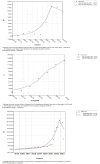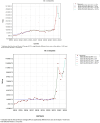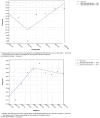Spending, utilization, and price trends for anti-obesity medications in U.S. Medicaid programs: an empirical analysis from 1999 to 2023
- PMID: 40740949
- PMCID: PMC12307327
- DOI: 10.3389/fmed.2025.1537181
Spending, utilization, and price trends for anti-obesity medications in U.S. Medicaid programs: an empirical analysis from 1999 to 2023
Abstract
Background: Obesity poses a significant public health and economic challenge in the United States (U.S.), with rising prevalence, particularly among individuals enrolled in Medicaid-the nation's public health insurance program for low-income populations. Anti-obesity medications (AOMs) have become integral to managing obesity, but trends in their utilization and spending within Medicaid remain underexplored.
Objective: To examine Medicaid's utilization, reimbursement, and price trends for AOMs from 1999 to 2023.
Methods: A retrospective analysis assessing the utilization, reimbursement, and pricing of older and newer AOMs. Yearly prescription numbers and reimbursement were calculated for seven AOMs billed through Medicaid between 1999 and 2023. The average expenditure per prescription was used as an indicator of drug pricing.
Results: AOM prescriptions rose from 13,855 in 1999 to 938,663 in 2023, a 6,674% increase. Spending surged by over 77,805,466% due to the introduction of newer, more effective medications, including Wegovy and tirzepatide. The largest share of the market growth in 2023 was driven by these medications.
Conclusion: The significant increase in AOM utilization and spending highlights the growing burden of obesity on Medicaid, emphasizing the need for policy measures to manage rising costs and ensure equitable access to treatment.
Keywords: COVID-19; Medicaid; obesity; pandemic; spending; trends; utilization.
Copyright © 2025 Alsuhibani, Alrasheed, Alhomoud, Alsahali, Almalki and Guo.
Conflict of interest statement
The authors declare that the research was conducted in the absence of any commercial or financial relationships that could be construed as a potential conflict of interest.
Figures







Similar articles
-
Longitudinal Analysis of Obesity Drug Use and Public Awareness.JAMA Netw Open. 2025 Jan 2;8(1):e2457232. doi: 10.1001/jamanetworkopen.2024.57232. JAMA Netw Open. 2025. PMID: 39878977 Free PMC article.
-
Quantifying the Role of Specialty Medications in Medicare Part D Expenditures in Dermatology.JAMA Dermatol. 2025 Jul 16:e252142. doi: 10.1001/jamadermatol.2025.2142. Online ahead of print. JAMA Dermatol. 2025. PMID: 40668561
-
A rapid and systematic review of the clinical effectiveness and cost-effectiveness of paclitaxel, docetaxel, gemcitabine and vinorelbine in non-small-cell lung cancer.Health Technol Assess. 2001;5(32):1-195. doi: 10.3310/hta5320. Health Technol Assess. 2001. PMID: 12065068
-
Trends in the utilization, expenditure and costs of noninsulin glucose-lowering drugs in the Medicaid population: Steady increases in glucagon-like peptide-1 receptor agonist and sodium-glucose transporter-2 inhibitor use, prices and expenditure.Br J Clin Pharmacol. 2025 Jul 9. doi: 10.1002/bcp.70162. Online ahead of print. Br J Clin Pharmacol. 2025. PMID: 40630025
-
[Volume and health outcomes: evidence from systematic reviews and from evaluation of Italian hospital data].Epidemiol Prev. 2013 Mar-Jun;37(2-3 Suppl 2):1-100. Epidemiol Prev. 2013. PMID: 23851286 Italian.
References
-
- WHO . Obesity and overweight. (2024). Available online at: https://www.who.int/news-room/fact-sheets/detail/obesity-and-overweight (Accessed October 9, 2024).
-
- State of Obesity Better Policies for a Healthier America—TFAH. (2023) Available online at: https://www.tfah.org/report-details/state-of-obesity-2023/ (Accessed October 3, 2024).
-
- CDC . Childhood Obesity Facts | Obesity. (2024). Available at: https://www.cdc.gov/obesity/childhood-obesity-facts/childhood-obesity-fa... (Accessed October 9, 2024).
LinkOut - more resources
Full Text Sources

